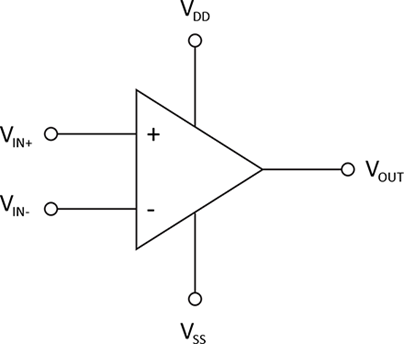Kevin Tretter, Senior Product Marketing Manager of the MSLD business unit, Microchip Technology Inc.
Opamps remain an integral component of most electronic systems.
Operational amplifiers (commonly known as “op amps” or “opamps”) are still an integral component of most electronic systems. Given the ubiquitous nature of these components, let us take a step back and review the elements of an operational amplifier and consider why it remains such a useful element in today’s electronic designs.
Are people still using operational amplifiers? Working the floor of a trade show years ago, I was asked, “Are people still using op amps?” I couldn’t help but smile, as the operational amplifier market is estimated to be over three billion dollars and growing. But to the questioner’s point, the tried-and-true opamp has been around for a long time and—although it has experienced improvements due to process technology, enhanced architectures, and design techniques—it remains fundamentally the same.
The “ideal” opamp
Let’s begin with the theoretical operation of the device. An operational amplifier is an electronic device that utilizes two inputs—an inverting input and a non- inverting input—an output, and a dual power supply. The opamp amplifies the difference between the two input signals to produce an output signal. An “ideal” operational amplifier is a theoretical device that has the following characteristics:
• Infinite open-loop gain: The output voltage (VOUT) will be equal to the difference between the input voltages (VIN+ – VIN-) multiplied by infinity. This characteristic allows the opamp to amplify even the smallest input signals.
• Infinite input impedance: This implies that the amplifier draws no current from the input source. This allows the opamp to be used with high-impedance sources, such as sensors and transducers, without affecting the input signal.
• Zero output impedance: The amplifier can drive any load without affecting the output voltage. This characteristic makes the opamp very useful for driving low-impedance loads, such as loudspeakers.
• Infinite bandwidth: This characteristic is related to the infinite open-loop gain described above. It allows the opamp to amplify signals of any frequency without roll-off. This characteristic enables the opamp to be used in applications that require high-frequency amplification, such as RF amplifiers, or applications that require high closed-loop gain.
• Zero input offset voltage: The output voltage will be zero when the input voltages are equal. This characteristic allows the opamp to be used in applications that require precise signal processing.
• Infinite slew rate: The op amp can respond to changes in the input signal instantly. This allows the amplifier to be used in applications that require fast signal processing, such as in high-speed data transmission.
While no opamp can meet all these ideal characteristics in the real world, modern opamps come close to achieving many of them. Designers must choose the opamp that best fits the requirements of their specific application, considering the real-world limitations of the device and the performance trade-offs involved.

Common uses for opamps
As noted earlier, opamps continue to be used in a wide range of electronics. Some of the most common applications for opamps include the following:
• Amplification/Attenuation: Opamps can be used as voltage amplifiers to increase or decrease the amplitude of an input signal. The gain of the amplifier is determined by the ratio of the feedback and input resistors, as well as how the feedback loop is configured from the opamp output to the inputs.
• Filters: Opamps can be used to build a variety of filters, including high- pass, low-pass, band- pass, and band-stop implementations. These filters are used to pass desired frequencies and block (remove) unwanted frequencies to allow for better measurement of the signal of interest.
• Comparators: Opamps can be used as comparators to compare two voltages and produce an output signal that indicates which voltage is higher. This is useful in applications such as level detection, threshold detection, and pulse-width modulation. There are limitations when using an opamp as a comparator, as opamps are specifically designed to work within the linear region (between the supply rails), so caution must be exercised.
• Oscillators: Opamps can be used to build oscillators that produce a sinusoidal waveform at a specific frequency. There are various types of opamp oscillators, such as Wien bridge, phase-shift, and crystal oscillators.
• Voltage regulators: Opamps can be used to build voltage regulators that maintain a constant output voltage regardless of changes in input voltage or load. Voltage regulators are used in a variety of electronic devices, such as power supplies, audio amplifiers, and motor controllers.
• Instrumentation amplifiers: Opamps can be used to build instrumentation amplifiers that amplify very small differential signals, such as those from sensors or transducers. Instrumentation amplifiers have high input impedance, low output impedance,
and a high common-mode rejection ratio (CMRR), thereby making them ideal for isolating and measuring small differential signals.
• Voltage followers: Voltage followers can also be referred to as unity gain amplifiers or buffer amplifiers. This function is useful in isolating circuitry from high switching currents or driving heavy loads such as an analog- to-digital converter (ADCs) or low impedance cables.
• Integrators and differentiators: Opamps can be used as integrators and differentiators to perform mathematical operations on analog input signals. Integrators produce an output signal that is proportional to the integral of the input signal, while differentiators produce an output signal that is proportional to the derivative of the input signal.
Conclusion
Overall, opamps are essential component in many electronic circuits, and their versatility and ease of use continue to make them a popular choice for designers and engineers. While no opamp can achieve the ideal characteristics described earlier, an understanding of these parameters and how they impact the application circuit will aid designers in selecting the best component to meet the requirements of their specific design.

